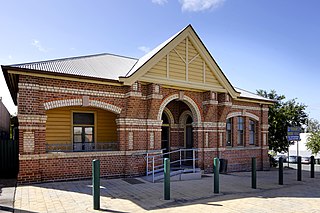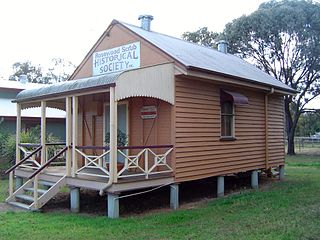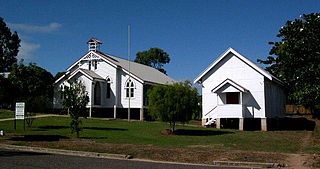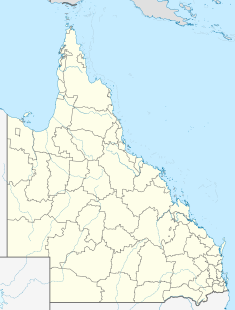
Cardwell Bush Telegraph is a heritage-listed former post office and now heritage centre at 53 Victoria Street, Cardwell, Cassowary Coast Region, Queensland, Australia. The Telegraph and Post Office at Cardwell was designed by Colonial Architect's Office and built in 1870 by George McCallum, making it one of the oldest buildings in North Queensland.

The Town of Croydon was a local government area for the governance of Croydon, Queensland, Australia. It existed from 1892 to 1908.
Gladstone House and Cottage is a heritage-listed detached house at 1B–3 Gladstone Street, Newtown, Toowoomba, Toowoomba Region, Queensland, Australia. It was designed by Harry Marks for himself and built c. 1908. It is also known as St Rest. It was added to the Queensland Heritage Register on 13 January 1995.

Toombul Shire Hall is a heritage-listed town hall at 1141 Sandgate Road, Nundah, City of Brisbane, Queensland, Australia. It was designed by John Hall & Son and built from 1891 to 1891. It is also known as Toombul Divisional Board Offices. It was added to the Queensland Heritage Register on 21 October 1992.

Rosewood Scrub Historical Society Building is a heritage-listed former shire hall at 73 Edmond Street, Marburg, City of Ipswich, Queensland, Australia. It was built in 1913 by Anton Jendrachowski. It is also known as Rosewood Shire Council Branch Office, Rosewood Shire Council Office, and Walloon Shire Council Office & Meeting Hall. It was added to the Queensland Heritage Register on 21 October 1992.

North Pine Presbyterian Church is a heritage-listed former Presbyterian and now Lutheran church at Dayboro Road, Whiteside, City of Moreton Bay, Queensland, Australia. The church was built from 1883 to 1884 and was added to the Queensland Heritage Register on 21 October 1992.

The Gympie Town Hall is a heritage-listed town hall at 2 Caledonian Hill, Gympie, Queensland, Australia. It was designed by Department of Public Works (Queensland) and John James Clark and built in 1939 by Marberete Company Pty Ltd, Department of Public Works, and Joseph Jew. It was added to the Queensland Heritage Register on 12 August 2011.

The Bank of New South Wales is a heritage-listed former bank at 242 Mary Street, Gympie, Gympie Region, Queensland, Australia. It was designed by Richard Gailey and built from 1890 to 1891 by T. Kelly. It is also known as Widgee Shire Council Chambers, Coolooa Shire Council Chambers and Gympie Regional Council Chambers. It was added to the Queensland Heritage Register on 15 April 2011.

Rockhampton Post Office is a heritage-listed former post office at 80 East Street, Rockhampton, Rockhampton Region, Queensland, Australia. It was designed by George St Paul Connolly and built from 1892 to 1896 by Dennis Kelleher. It is also known as Rockhampton Post and Telegraph Offices. It was added to the Queensland Heritage Register on 24 January 2003.

Strathmore Homestead is a heritage-listed homestead at Strathmore Station on Strathmore Road, Springlands, Whitsunday Region, Queensland, Australia. It was built from the 1860s onward. It is also known as Strathmore Station. It was added to the Queensland Heritage Register on 13 November 2008.

West End Hotel is a heritage-listed hotel at 89 Ingham Road, West End, City of Townsville, Queensland, Australia. It was built in 1885 by Peter Dean. It was added to the Queensland Heritage Register on 24 June 1999.

St John's Anglican Church Precinct is a heritage-listed churchyard at 30–34 Macrossan Street, South Townsville, City of Townsville, Queensland, Australia. It was built from c. 1907 to c. 1911. It was added to the Queensland Heritage Register on 21 October 1992.

Seagren's Building is a heritage-listed workshop at 124 Charlotte Street, Cooktown, Shire of Cook, Queensland, Australia. It was built from 1880s to c. 1900. It is also known as Motor Inn Motel and Seagren's Inn. It was added to the Queensland Heritage Register on 21 October 1992.

Croydon Court House is a heritage-listed former courthouse at Samwell Street, Croydon, Shire of Croydon, Queensland, Australia. It was designed by Colonial Architect's Office and built in 1887. It was added to the Queensland Heritage Register on 21 October 1992.

Croydon Police Station is a heritage-listed former police station at Samwell Street, Croydon, Shire of Croydon, Queensland, Australia. It was built in 1899. It is also known as Former Police Station and Residence. It was added to the Queensland Heritage Register on 23 July 1999.

Croydon Hospital Ward is a heritage-listed former hospital at Sircom Street, Croydon, Shire of Croydon, Queensland, Australia. It was built in 1894. It is also known as Croydon State Emergency Services Building. It was added to the Queensland Heritage Register on 21 October 1992.

Murgon Civic Centre is a heritage-listed town hall at 62–70 Lamb Street, Murgon, South Burnett Region, Queensland, Australia. It is also known as Murgon Public Hall. It was designed by Clifford Ernest Plant and built in 1938 by HG Neilsen. It was added to the Queensland Heritage Register on 9 November 2012.

Hibernian Hall is a heritage-listed community hall at 38–44 Hawthorne Street, Roma, Maranoa Region, Queensland, Australia. It was designed by Cavanagh & Cavanagh and built from 1931 to 1932 by George Power Williams. It is also known as HACBS Hall. It was added to the Queensland Heritage Register on 27 April 2001.

Warroo Shire Hall is a heritage-listed town hall at cnr Cordelia & William Streets, Surat, Maranoa Region, Queensland, Australia. It was designed by Harry Marks and was built in 1929 by K O'Brien and C Turnbull. It was added to the Queensland Heritage Register on 8 May 2007.

Tambo Post Office is a heritage-listed former post office and now museum at Arthur Street, Tambo, Blackall-Tambo Region, Queensland, Australia. It was built in 1876 and 1885. It is also known as Post and Telegraph Office Tambo and Tambo Telecommunications Museum. It was added to the Queensland Heritage Register on 21 October 1992.






















